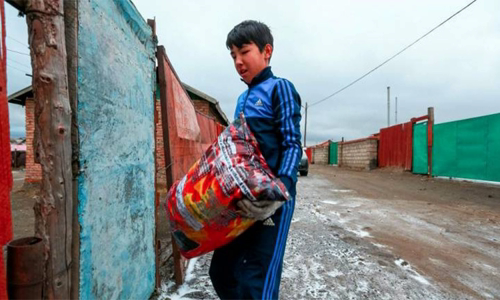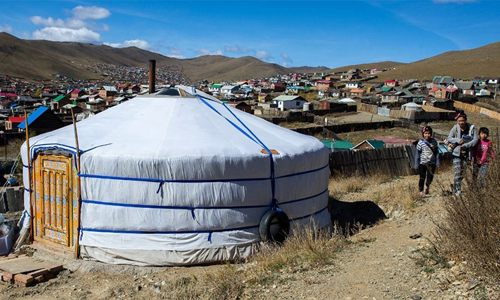Gerel Ganbaatar stayed at his parents' house on a cold October night in the outskirts of Ulanbator, not expecting it to be the last night in her life.
Just a few hours after resting in the traditional "ger" tent, both Ganbaatar and his parents were short of breath and nauseous. They called for help, but by the time the doctor arrived, Ganbaatar, who was four months pregnant, had stopped breathing.

A boy in Ulaanbaatar carried a smokeless charcoal bag after he bought it on October 19 Photo: AFP.
On that fateful night, the 29-year-old girl's parents for the first time used smokeless briquettes for heating. This is a coal distributed by the Mongolian government, made from coke in the Gobi desert and coal powder, which has the potential to cause death and adverse health effects.
Ganbaatar is not the only fatal case when heated with this briquette. Since the people of Mongolia began using the new coal in October, there have been 7 deaths, mostly children, pregnant women and the elderly, not to mention nearly a thousand people were hospitalized in favelas on the outskirts of Ulanbator.
Experts are concerned that the new briquettes could cause carbon monoxide poisoning, a colorless, odorless poison gas.
Jargalsaikhan Mishigdorj, Ganbaatar's mother, warned that briquettes should be used with caution. "I have been burning coals all my life, but I have never been suffocated," Mishigdorj said.
The Mongolian government is trying to control the emissions of haze in Ulanbator, one of the most polluted cities in the world, by replacing the old coal-burning coal. This coal is often used by the poor to warm up when the outdoor temperature drops to -40 degrees Celsius. Mongolian officials explain that the new briquettes last longer, producing less smoke.
An unnamed nurse at the Mongolian National Poison Emergency Hospital said she had never seen such a high number of CO poisoning patients. "We are working with high intensity," she said.
Meanwhile, the city emergency agency said that if people know how to burn briquettes properly, the situation of coal poisoning will be minimized. They said public health service workers spent time on "ger" buildings to teach people how to use the new heating fuel, as well as to detect cases of continuing burning charcoal.
Ulanbator is the coldest capital in the world and only half of residents have central heating. It is also a place often not meeting the World Health Organization (WHO) recommendations for air quality.

A traditional ger house of the Mongols Photo: ADB.
The Mongolian government's efforts yielded some initial positive results. The amount of PM 2.5 fine dust has decreased 40% in Ulanbator compared to October last year, according to Sonomdagva, an associate professor at the National University of Mongolia.
But Mr. Sonomdagva explained that the long warm season and the suffocation of the cessation of using the new coal that made people heat only with firewood could also be the reason for the fine dust reduction.
Byambajargal Losol, a physicist at the Mongolian Academy of Sciences, believes that using smokeless briquettes is the best way to reduce air pollution, but needs to help people use it more safely.
"People are using briquettes like charcoal before and burning them in the same way. But the briquettes are thicker, more tightly compressed so they need twice the amount of oxygen than charcoal," Losol said. The scientist explained that CO poisoning only occurs when the supply of oxygen to the fireplace is limited.
The Mongolian-owned briquette factory recommends that families clean the stove before burning a new coal, and provide free kitchen renovation services after problems with this type of charcoal are available. mentioned in the press. The government is also committed to distributing free smoke sensors in "ger" buildings.
The new type of briquette has also received positive reviews. "A bag of briquettes can last for 3 days, while charcoal can only be used for a day," Turbold Sainbuyan, a resident of the "ger" house, said.
Sainbuyan's mother, Enkhjargal Chuluun, a nurse at a private clinic, said she was worried even though the briquettes were warmer than charcoal. "We were still afraid of suffocating, so we opened the window at night," Chuluun said.



 RichieEmbry
RichieEmbry







